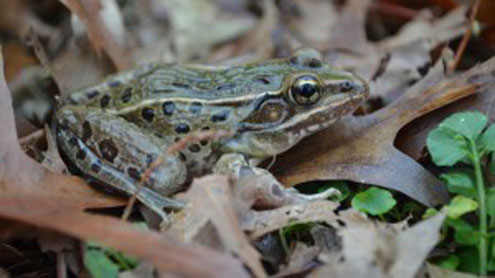Biologists recently discovered a new leopard frog species in the ponds and marshes of Staten Island, mainland New York and New Jersey, according to a press release.
Scientists from UCLA, Rutgers University, UC Davis and the University of Alabama worked together to discover the new species, said Catherine Newman, a Ph.D. student at Louisiana State University. The species has currently not been described or given an official name.
Newman, alongside Rutgers University student Jeremy Feinberg, is the lead author of the paper about the new species and said she and Feinberg decided to further investigate a few populations of frogs they had found with calls that sounded different from the northern and southern leopard frogs they normally studied.
“[Feinberg] and others sent me clips of the odd-sounding frogs, and I did genetic analyses to determine whether the frogs were odd-sounding frogs of the northern or southern leopard frog, a hybrid between northern and southern leopard frog or a new species,” Newman said. “Our genetic analyses showed that the odd-sounding frogs were a new species that looks like the known leopard frog but sounds different and is also genetically different.”
The paper is titled “A new species of leopard frog (Anura: Ranidae) from the urban northeastern U.S.” and can be found online in the Molecular Phylogenetics and Evolution journal at sciencedirect.com.
Leslie Rissler, associate professor of biological sciences at the University of Alabama, said the new species is at least six percent diverged from its sister species, the pickerel frog. Rissler said this is a lot if one considers that humans and chimpanzees are less than two percent diverged.
“It is not unusual to discover a new species in remote areas of the world, but it is rare to find a large vertebrate in one of the most populated parts of the world – New York City,” Rissler said. “Amphibians are of particular importance because a third of them are fully threatened with extinction, more than any group of vertebrate.”
Although the frogs may exist in parts of Connecticut and northeastern Pennsylvania, evidence suggests that they were once common on Long Island and other nearby regions but went extinct in the last few decades.
Leopard frogs are often found in people’s backyards in the region, and the person may not realize it is a new species, Newman said.
“These frogs have not been hiding from us; rather, they have been hiding in plain sight,” Newman said. “This research is particularly important because it highlights a densely urban region of the world where discovery of new vertebrate species is unlikely, and it emphasizes the urgency with which we should continue to study urban biodiversity so we can effectively protect species that face population declines. We are very excited about this discovery.”









